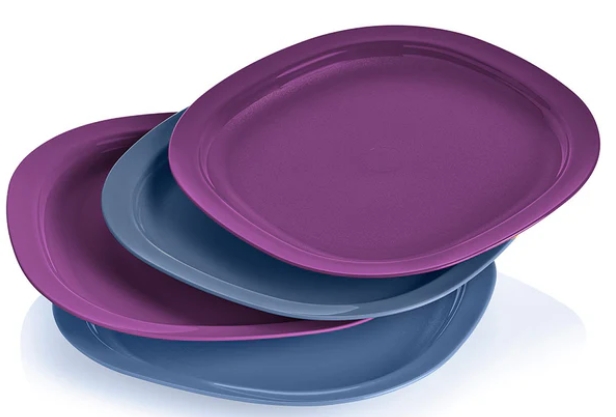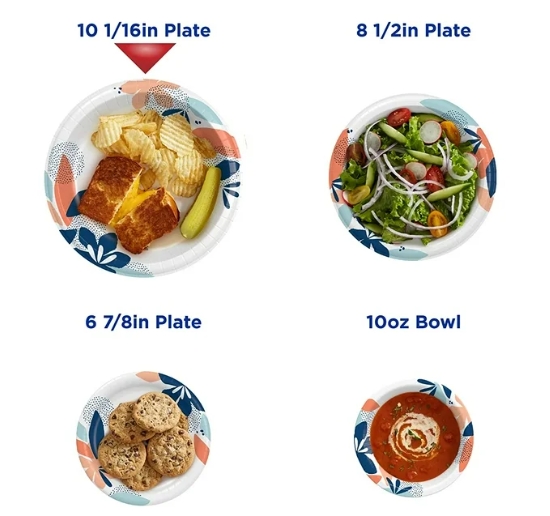
Content Menu
● Understanding Lunch Disposable Plates
>> Types of Lunch Disposable Plates
>> Why Microwave Safety Matters
● How to Determine if a Lunch Disposable Plate is Microwave-Safe
>> Check for Microwave-Safe Labels
>> Material Matters
>> The Home Microwave Test
● Risks Associated with Microwaving Lunch Disposable Plates
>> Chemical Leaching
>> Melting and Warping
>> Fire Hazards
>> Food Contamination
● Best Practices for Microwaving Lunch Disposable Plates
>> General Guidelines
>> Specific Plate Types
>>> Paper Plates
>>> Plastic Plates
>>> Compostable Plates
>>> Coated Plates
● Eco-Friendly Alternatives for Microwave Use
>> Sugarcane Bagasse Plates
>> Bamboo Plates
>> Certified Compostable Plates
● Common Misconceptions About Lunch Disposable Plates and Microwaves
>> All Paper Plates Are Microwave-Safe
>> Plastic Plates Are Always Unsafe
>> Compostable Means Microwave-Safe
>> Short Bursts Are Always Safe
● Environmental Considerations
● Conclusion
● FAQ
>> 1. How can I tell if my lunch disposable plate is microwave-safe?
>> 2. Are all paper lunch disposable plates safe for microwaving?
>> 3. Can I microwave plastic lunch disposable plates?
>> 4. What are the safest eco-friendly lunch disposable plates for microwave use?
>> 5. What should I avoid when microwaving lunch disposable plates?
Lunch disposable plates are a modern convenience, making it easy to serve meals at picnics, office lunches, parties, and family gatherings. Their lightweight design, low cost, and hassle-free cleanup have made them a go-to choice for many households and businesses. As microwaves have become an essential part of food preparation and reheating, a common question arises: are lunch disposable plates safe for microwave use?
This comprehensive guide explores the safety of various types of lunch disposable plates in the microwave, examining their materials, coatings, and best practices. By understanding how different disposable plates interact with microwave heat, you can make informed choices that protect your health and enhance your dining experience.

Understanding Lunch Disposable Plates
Types of Lunch Disposable Plates
Lunch disposable plates are available in several forms, each with unique properties:
- Paper Plates: Typically made from wood pulp, sometimes with coatings for added strength or moisture resistance.
- Plastic Plates: Manufactured from various polymers, often designed for single use.
- Compostable Plates: Made from plant fibers such as sugarcane bagasse, bamboo, or cornstarch.
- Coated Plates: Paper or plant-fiber plates with a thin plastic or wax coating to prevent soaking.
Each type has distinct characteristics that affect its suitability for microwave use.
Why Microwave Safety Matters
Microwaving food on unsuitable materials can lead to several issues:
- Harmful chemicals may leach into your food.
- Plates may melt, warp, or catch fire.
- The microwave itself can be damaged.
- Food may be contaminated or taste altered.
Given these risks, understanding which lunch disposable plates are microwave-safe is essential for both safety and convenience.
How to Determine if a Lunch Disposable Plate is Microwave-Safe
Check for Microwave-Safe Labels
The most reliable way to determine if a lunch disposable plate is microwave-safe is to look for a clear label on the packaging or the bottom of the plate. Manufacturers often use symbols, such as wavy lines, or text indicating “microwave-safe.” If there is no such marking, proceed with caution.
Material Matters
- Plain Paper Plates: Generally safe for short microwave use, especially if uncoated and unprinted. Avoid plates with heavy inks, metallic decorations, or recycled content that may contain unknown additives.
- Plastic Plates: Only use those labeled as microwave-safe. Plates made from BPA-free plastics are preferable, as some plastics can leach chemicals when heated.
- Compostable Plates: Plates made from sugarcane bagasse or bamboo are often microwave-safe, but always verify with the manufacturer. Avoid cornstarch-based or paper compostables unless specifically labeled as microwave-safe.
- Coated Plates: Plates with wax or plastic coatings may melt or release chemicals under heat. Unless labeled as microwave-safe, avoid microwaving these.
The Home Microwave Test
If you are unsure about a plate's safety, you can perform a simple test at home:
1. Place the empty plate in the microwave next to a cup of water.
2. Microwave on high for one minute.
3. If the plate remains cool while the water heats up, it is likely microwave-safe. If the plate becomes hot, it is not suitable for microwave use.
Risks Associated with Microwaving Lunch Disposable Plates
Chemical Leaching
Some disposable plates, especially those with plastic coatings or made from non-BPA-free plastics, can release harmful chemicals into food when heated. These chemicals, such as BPA or phthalates, have been linked to health concerns. Choosing plates that are certified microwave-safe and BPA-free is crucial for your well-being.
Melting and Warping
Plastic and coated plates may melt or warp in the microwave, especially when exposed to high temperatures or prolonged heating. This not only ruins the plate but can also cause food spills and create a mess inside your microwave.
Fire Hazards
Paper plates, particularly thin or recycled varieties, can catch fire if overheated or used for too long in the microwave. Plates with metallic decorations or linings can cause sparking and pose a fire risk.
Food Contamination
Plates not designed for microwave use may break down, leach chemicals, or impart off-flavors to food, compromising both safety and taste.

Best Practices for Microwaving Lunch Disposable Plates
General Guidelines
- Always use plates labeled as microwave-safe.
- Limit microwave time to short intervals, generally under two minutes, to avoid overheating.
- Avoid microwaving greasy, oily, or high-fat foods on thin paper plates, as these can cause the plate to break down or catch fire.
- Never use plates with metallic elements, heavy inks, or glossy finishes in the microwave.
- If in doubt, transfer food to a glass or ceramic plate before microwaving.
Specific Plate Types
Paper Plates
- Opt for plain, uncoated, and unprinted varieties.
- Avoid prolonged heating and high-fat foods.
Plastic Plates
- Only use BPA-free, microwave-safe plastics.
- Avoid microwaving if the plate is not clearly labeled as microwave-safe.
Compostable Plates
- Sugarcane bagasse and bamboo plates are generally safe, but always check packaging.
- Avoid cornstarch-based or paper compostables unless specifically labeled as microwave-safe.
Coated Plates
- Avoid unless the packaging explicitly states microwave safety.
- Wax or plastic coatings can melt and contaminate food.
Eco-Friendly Alternatives for Microwave Use
Sugarcane Bagasse Plates
Sugarcane bagasse plates are increasingly popular for their durability, heat resistance, and compostability. They are typically uncoated or lined with plant-based materials, making them safer for microwave use compared to plastic- or wax-coated plates.
Bamboo Plates
Bamboo fiber plates offer similar benefits, with high heat tolerance and biodegradability. They are a sustainable alternative for those seeking microwave-safe disposable options.
Certified Compostable Plates
Look for certifications such as BPI (Biodegradable Products Institute) or compostability marks, as these often indicate that the plate is free from harmful coatings and suitable for microwave use.
Common Misconceptions About Lunch Disposable Plates and Microwaves
All Paper Plates Are Microwave-Safe
Not all paper plates are created equal. Coated, heavily printed, or recycled paper plates may contain additives that are unsafe for microwave use.
Plastic Plates Are Always Unsafe
Some plastic plates are designed specifically for microwave use, particularly those marked as BPA-free and microwave-safe. The key is to check for proper labeling.
Compostable Means Microwave-Safe
Compostable plates made from materials like sugarcane or bamboo are often microwave-safe, but not all compostable plates are. Always verify with the manufacturer or packaging.
Short Bursts Are Always Safe
Even microwave-safe plates can break down if overheated or used for prolonged periods. Stick to short bursts and monitor the plate's condition.
Environmental Considerations
Choosing microwave-safe lunch disposable plates is not just about personal safety; it also impacts the environment. Opt for plates that are:
- Biodegradable or compostable, which reduces landfill waste.
- Free from harmful chemicals, ensuring safety for both you and the planet.
- Made from renewable resources, such as sugarcane or bamboo.
By selecting eco-friendly, microwave-safe options, you support both your health and environmental sustainability.
Conclusion
Lunch disposable plates offer unmatched convenience, but not all are suitable for microwave use. The safety of microwaving these plates depends on their material, coatings, and manufacturer's guidelines. Always look for microwave-safe labels, avoid coated or heavily printed plates, and favor eco-friendly alternatives like sugarcane bagasse or bamboo fiber plates.
By following best practices and making informed choices, you can enjoy the convenience of lunch disposable plates without compromising safety or environmental responsibility.

FAQ
1. How can I tell if my lunch disposable plate is microwave-safe?
Look for a “microwave-safe” label, wavy symbol, or check the packaging for specific instructions. If there is no clear indication, perform the home microwave test: place the plate in the microwave with a cup of water and heat for one minute. If the plate stays cool while the water heats up, it is likely safe for microwave use.
2. Are all paper lunch disposable plates safe for microwaving?
No, only plain, uncoated, and unprinted paper plates are generally safe for short microwave use. Plates with plastic or wax coatings, heavy inks, or metallic decorations should be avoided, as they may release chemicals or catch fire.
3. Can I microwave plastic lunch disposable plates?
Only microwave plastic plates that are labeled as microwave-safe and BPA-free. Plates without these labels may melt or leach harmful chemicals into your food.
4. What are the safest eco-friendly lunch disposable plates for microwave use?
Plates made from sugarcane bagasse or bamboo fiber are among the safest eco-friendly options for microwave use, provided they are certified as microwave-safe. These materials are durable, heat-resistant, and biodegradable.
5. What should I avoid when microwaving lunch disposable plates?
Avoid using plates with metallic elements, glossy finishes, or heavy inks. Do not microwave plates that lack a microwave-safe label, and never use plates for prolonged heating or with greasy, oily foods unless specified as safe for such use.

















